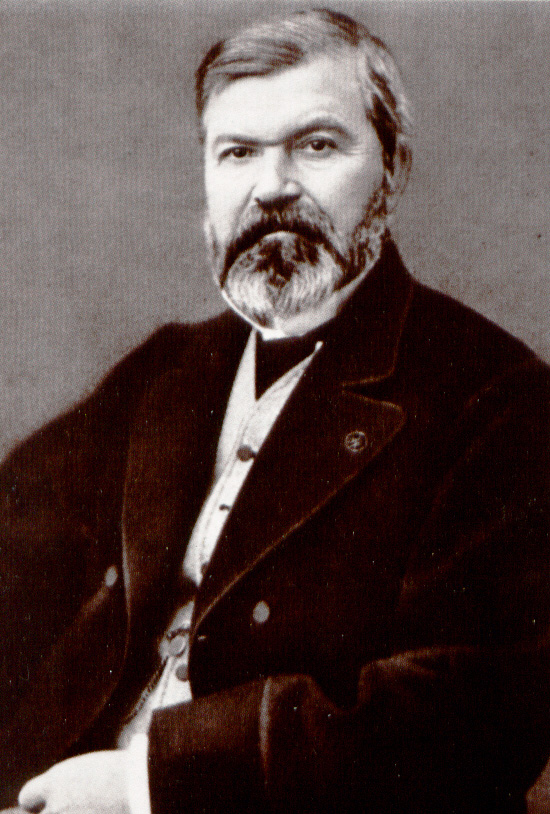Jean Adolphe Braun was a French photographer, best known for his floral still lifes, Parisian street scenes, and grand Alpine landscapes. One of the most influential French photographers of the 19th century, Braun used contemporary innovations in photographic reproduction to market his photographs worldwide. In his later years, he used photographic techniques to reproduce famous works of art, which helped advance the field of art history.
Braun was born in Besançon in 1812, the eldest child of Samuel Braun (1785–1877), a police officer, and Marie Antoinette Regard (born 1795). When he was about 10, his family relocated to Mulhouse, a textile manufacturing center in the Alsace region along the Franco-German border. He showed promise as a draftsman, and was sent to Paris in 1828 to study decorative design. In 1834, he married Louis Marie Danet, who he had three children with: Marie, Henri, and Louise. That same year, Adolphe, alongside his brother Charles, opened the first of several unsuccessful design partnerships.
After several unsuccessful design ventures in the 1830s, Adolphe Braun published a successful collection of floral designs in 1842. Upon the premature death of his wife 1843, Braun sold his Paris studio and moved back to Mulhouse, where he became chief designer in the studio of Dollfus-Ausset, which provided patterns for textiles. He remarried to Pauline Melanie Petronille Baumann (1816–1885) on 12 December 1843 and had two more children with her; son Paul Gaston and daughter Marguerite.
In 1847, he opened his own studio in Dornach, a suburb of Mulhouse. In the early 1850s, Braun began photographing flowers to aid in the design of new floral patterns. Making use of the recently developed collodion process, which allowed for print reproduction of the glass plates, he published over 300 of his photographs in an album,
Fleurs photographiées, in 1855. These photographs caught the attention of the Paris art community, and Braun produced a second set for display at the Paris Universal Exposition that same year.
In 1857, Adolphe Braun formed a photography company, Braun et Cie, and with the help of his sons, Henri and Gaston, and several employees, set about taking photographs of the Alsatian countryside. These were published in 1859 in
L’Alsace photographiée, and several were displayed at the 1859 Salon. By the 1860s, the Braun et Cie studio was operating in a factory-like manner, producing all of its own materials except paper. The studio created thousands of stereoscopic images of the Alpine regions of France, Germany, Switzerland, and Italy. Braun also produced a number of large-format panoramic images of the Alpine countryside, using the pantoscopic camera developed by English inventors John Johnson and John Harrison.
Photography historian
Naomi Rosenblum described Braun's work as representative of the relationship between art and commercialism in the mid-19th century. His self-sustaining Mulhouse studio helped elevate photography from a craft to a full-scale business enterprise, producing thousands of unique images which were reproduced and marketed throughout Europe and North America. Rosenblum also suggests that Braun's detailed reproductions of works of art in European museums brought these works to art students in North America, providing a major catalyst for the field of art history in the United States.
Braun's early photographs were primarily of flowers, originally taken to complement his work as a pattern designer. Subsequent photographs focused on Alpine landscapes, especially lake scenes, and glacier scenes. Unlike many landscape photographers during this period, Braun liked to include people in his scenes. Photography historian
Helmut Gernsheim suggested that Braun was one of the most skillful photographers of his era in rendering composition. While not known as a portraitist, he did take portraits of several notable individuals, including Pope Pius IX, Franz Liszt, and the Countess of Castiglione, mistress of Napoleon III.
Braun's work has been exhibited at the
Metropolitan Museum of Art,
The J. Paul Getty Museum, the
George Eastman House, and the
Musée d'Orsay. His photographs of Parisian street scenes and Alpine landscapes are frequently reproduced in works on the history of photography.
Source: Wikipedia
Trained as a fabric designer, Adolphe Braun began his photography career in 1853. His photographs of flowers, for a catalog titled
Fleurs photographiées, were to be transferred onto printing blocks for wallpaper and fabric designs. It was an extremely successful project for Braun; one album of the photographs was presented to Empress Eugénie of France, and it earned him a medal at the 1855 Paris Exposition Universelle.
By the early 1860s, Braun's focus had shifted to the making of topographical views of scenes throughout Europe and, beginning in 1866, to reproductions of works of art. The reproduction of paintings, drawings, lithographs, engravings, and sculpture was an important endeavor in France, and photography provided an accurate record. Braun opened a photography studio that became one of the world's largest publishers of such images. In 1869 Braun's was one of only two photographic firms invited to photograph the opening of the Suez Canal in Egypt.
Source: The J. Paul Getty Museum
